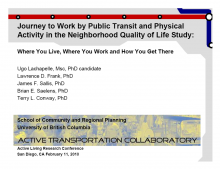We are pleased to announce an exciting new alliance between Active Living Research and GP RED to co-host and coordinate...
Journey to Work by Public Transit and Physical Activity in the Neighborhood Quality of Life Study

Presentation at the 2010 Active Living Research Annual Conference
Background:
Many public transit users achieve physical activity recommendations by walking to and from transit.
Objectives:
This paper analyses the relationship between commuting by transit and objectively measured physical activity in different types of neighborhoods with contrasting development patterns. Self-reported numbers of walking trips from home and from work are compared between transit users and non-users to explore the mechanisms associated with more physical activity.
Methods:
This cross-sectional analysis relied on the Neighborhood Quality of Life Study (NQLS, 2001-2005), a community observational study sampled across four types of neighborhood in Seattle-King County and Baltimore-Washington DC regions. Neighborhoods either had high or low median income and high or low walkability (n=4 neighborhood types X 8 neighborhoods per category=32). Within neighborhoods, adults between age 20 and 65 were randomly selected from lists obtained from marketing companies. Those working outside of home were considered in this analysis (n=1239). Mean daily accelerometer-defined minutes of moderate to vigorous physical activity (MVPA) were regressed on frequent, infrequent and no commute by transit and neighborhood walkability and income in a model adjusting for individual demographic correlates and enjoyment of physical activity. Neighborhood random effects are used to adjust for clustering of respondents within neighborhoods. Models stratified by neighborhood walkability assessed whether the effect of commuting by transit on MVPA varied depending on community design factors. To understand the mechanism behind these relationships, associations between transit use and self-reported number of walking trips to various destinations near home and workplace are examined using chi square tests. Associations are not tested in a regression model because the direction of causality is not assumed.
Results:
A positive relationship between commute by transit and MVPA was found, when controlling for neighborhood walkability and individual-level socio-demographic covariates. Both in high and low neighborhood walkability, those commuting by transit, either frequently or infrequently, cumulated more MVPA, and engaged in more walk trips both near home and near the workplace than non-users of transit. Estimated values with other variables kept constant are for example of approximately 31 min. for no transit commute in low walkability, 42 min. for frequent commute in low walkability and 50 min. for frequent commute in high walkability. Enjoyment of physical activity did not confound the relationships and there was no evidence of a linear association between more commute by transit and greater enjoyment of physical activity. Transit users also take more walk trips to different services near home and the workplace than their non-user counter-parts, which explains their more active behavior beyond the walk to transit.
Conclusions:
This study demonstrates transit commuters do more objectively measured physical activity than non-transit commuters, adjusting for individual differences. This effect was observed regardless of neighborhood walkability and was not explained by transit users’ greater enjoyment of physical activity. Public health professionals could promote transit use with individuals as a means of increasing physical activity. They could also support transit infrastructure development with policy makers as a mean of reducing negative health externalities of auto-centric urban development. Policies to create walkable environments may be more supportive of walking if public transit provides an alternative to automobile travel for activities away from home.
Support:
We acknowledge the support of the National Institutes of Health, the Social Science Research Council of Canada and the Bombardier Foundation.
STAY UP TO DATE
RECENTLY ADDED TOOLS & RESOURCES
MOVE! A BLOG ABOUT ACTIVE LIVING
The "Active Living Conference" aims to break down research and practice silos and...







